Abstract
Antisocial Personality Disorder has been on the spotlight. Clinicians have sought the basis of the condition. Various theories have attempted to demystify the causes of the APD, however, research developing around the root cause of the condition point out psychologically instigated problems as core causes of the disorder.
Clinical and research has focused on establishing a specific parameter of the antisocial personality disorder. Early clinical accounts of what causes ‘antisocial personality disorder’ describe persons with the condition as people who cannot conform to social norms, especially morals and social values that form the disciplined civil society.
Antisocial Personality Disorder is best described as antisocial proclivity. Present conceptualizations of antisocial proclivity are presented in etiological theories that explain the context. This paper attempts to provide insight with regard to this condition, often referred to as psychopathic behavior. We achieve this through providing a detailed case study findings and a comprehensive literature review.
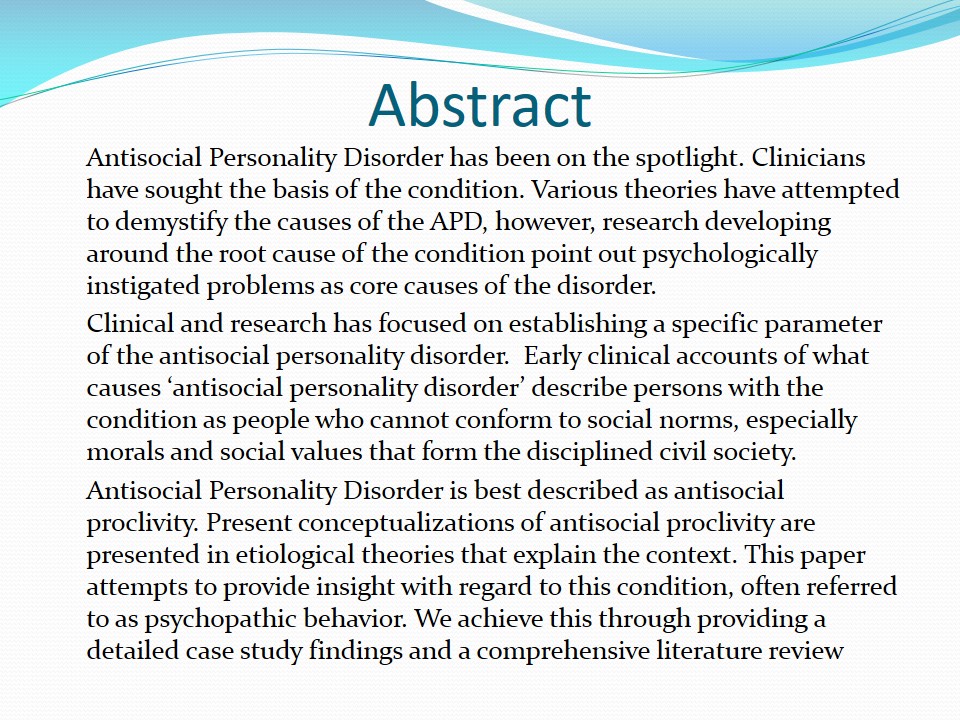
Introduction
Social behaviors have become very crucial in determining the outcome of values and future of our social economics. Psychological nomenclatures of behavior show that various psychological conditions provoke interest in on habits and mental health of people who fail to conform to moral and legal expectations of the society. Clinical approaches to such social conflicts describe these habits and conditions as psychological problems that are looked at from a psychological impairment perspective. Clinical approach explain that the behaviors of people whose habits ‘behaviors’ offend normative social culture and values derange and quell syptomatology that classify them as psychotic problems.
The actual diagnostic explanation depicts antisocial personality disorder as a behavior disorder denoting moral decadency. This does not suffice to provide comprehensive psych-medical explanation rather provide a societal view. However, a psychological approach provides a comprehensive rationale, describing antisocial personality disorder as aberrant, impulsiveness, and rage but not lacking reasoning capacity during when either of these psychosocial anomalies are triggered. As such, this can be best described as moral insanity from a literary perspective.
Clinicians who investigated this moral insanity have offered a mode definite explanation, citing this condition as possessed by individuals who are constitutionally deficient in moral faculties. Similar research conducted in 19th century found out that antisocial behavior was caused by organic constitutional elements. Those suffering from this condition assume that the organic factors have no prognosis for change and their deviant behavior is their reaction to the lack of chance of change of the social values and laws.
Literature dwelling on psychotic problem defines antisocial personality behavior as indicative of psychopathic personality. However, approaches that are more specific define antisocial personality disorder as a disposition to virtues. This disposition to antisocial personality disorder results from personal deficiencies and related psychological; anomalies (Stutker & Allain, 2002, p, 445).
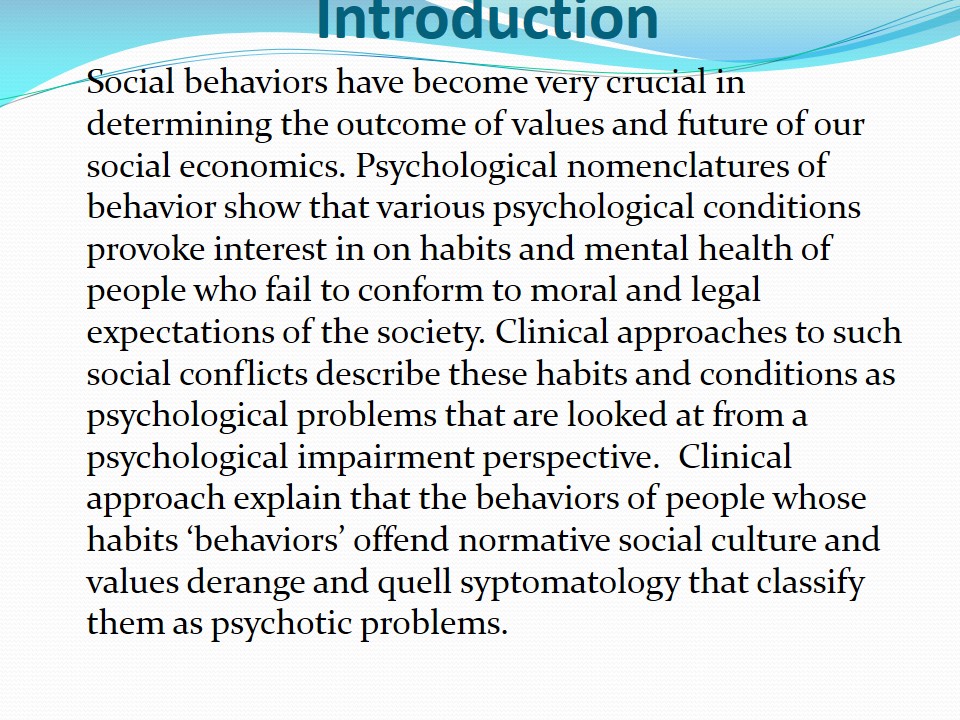
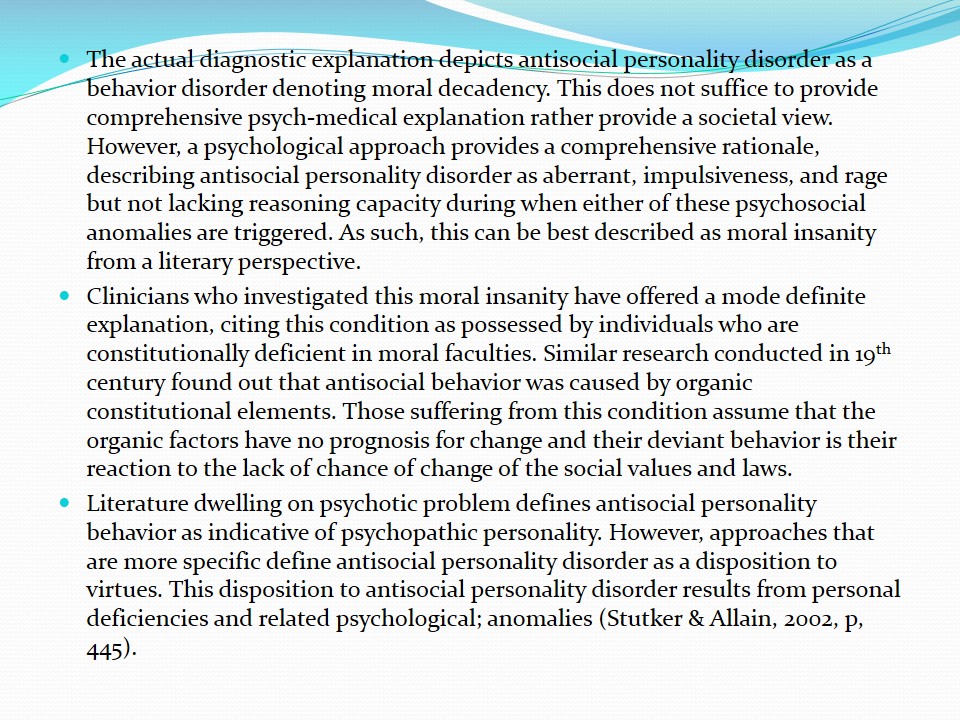
Case Study
Ann, a 32-year-old woman has little empathy for the feeling and wishes of other people. She has a great deal of charm, almost supernatural, which emanates from her desire to have a way. Ann has the ability to manipulate people into getting her way. Ann frequently violates the law and has behaviors that do not reflect good social values. Ann’s social history shows a pattern of frequent violation of her parent’s rules, and that she was always in trouble during her school days (Eisenman, 1993).
Ann, as mentioned earlier has no empathy for others feelings. She does not care about how people feel and what they want, rather likes to have own way. Ann exhibits a number of psychological impairment conditions. According to the diagnosis, Ann is suffering from a number of psychiatric conditions classified as DSM-IV. This condition is suspect of antisocial personality disorder. The diagnosis drew its facts from Ann’s development history. Ann, during her childhood was disobedient both at home and at school.
Today, Ann still has the same character. She has a conduct disorder, which has inhibited her development of a career, let a lone maintain a good job. This is blamed on her inability to respect others, an attempt to dominate and manipulate others to have her way, care about the needs of those she works with, and her failure to comply with terms and conditions of the workplace. Ann has consistently flouted the law both at work and in the society.
Ann needs counseling to arrest her problem. If this goes on, Ann will be unable to be acceptable in the society. She will be unable to progress in her life as a woman and fail to excel like a professional. This continuing pattern will certainly stop any meaningful development of her life. Serious counseling is required.
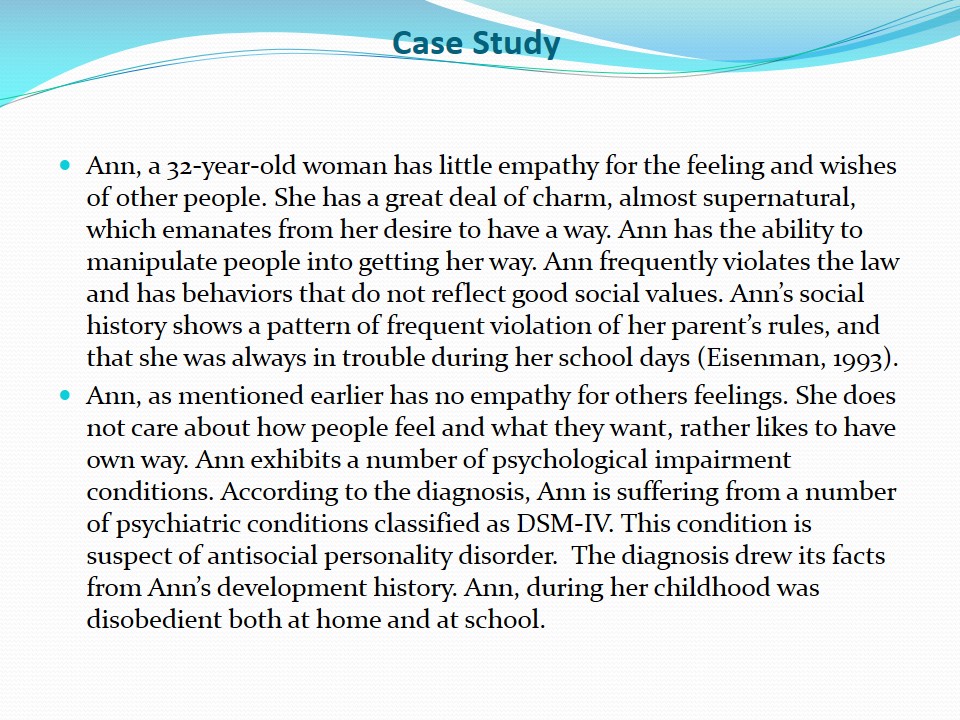
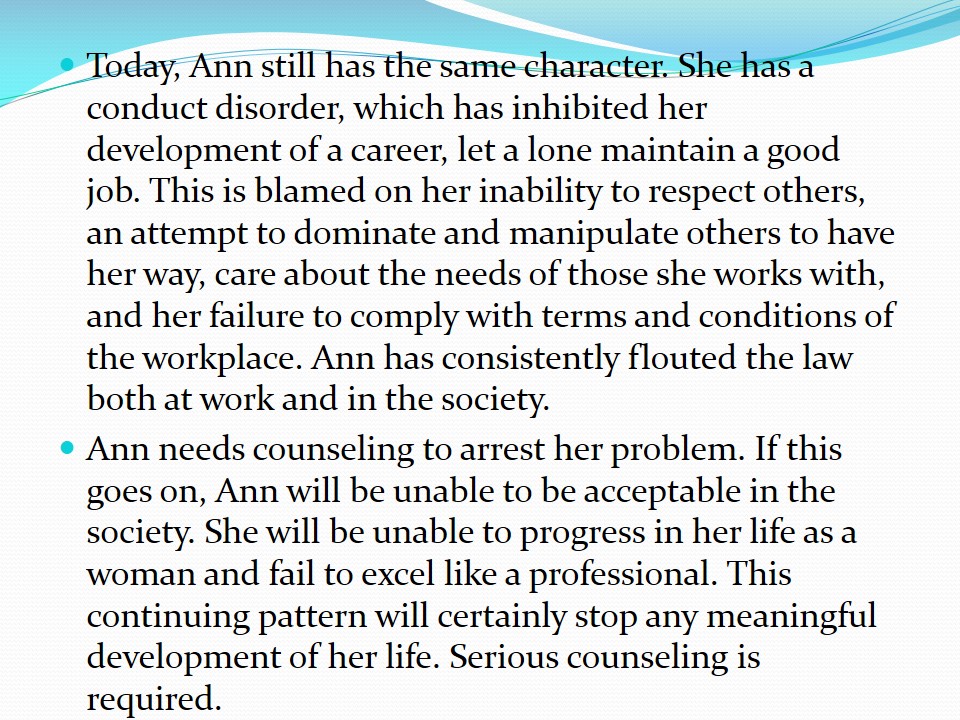
Literature Review
Meloy argues that antisocial personality disorder is one of the most reasonably diagnosed psychotic conditions but treatment of the condition is the most difficult since the condition is deeply manifested as a habit in the cohort. A large percentage of psychiatrists believe that this psychopathic problem is treatable. However, critical diagnosis is vital before any treatment is undertaken. Diagnosis helps determine the degree of psychopathy and this is critical in making the prognosis (Meloy, 2007, p, 1). According to Widiger, every person has his own manner of relating, thinking, and feeling in relation to those around him. These aspects of character are what denotes ones personality traits. If the personality traits become dysfunctional, they can warrant consequences such as antisocial personality disorder (Widiger, 2003, p, 131-135).
Diagnosis may vary depending on method and level of conversancy. The American psychiatric association’s diagnostic and statistical manual of mental disorders provides ten diagnosis procedures for personality disorder. The nomenclature is the most prominent for it provides a reliable solution to proper diagnosis of the disorder. However, Eisenman projects the diagnosis of psychopathic behavior as requiring a comprehensive diagnostics. He points out that most antisocial personality are completely sane individuals who are in good careers. This is where psychopathic personality is observed. Psychopathic refers to out of order character. It is a behavior indicative of little or no regard for the laws governing the society and the country.
People with this condition do reason and function normally. Their ability to behave in an inhumane behavior makes them bad for the society. The DSM-IV is one of the most common parameter of manifestation of the antisocial personality disorder. After antisocial personality disorder has been diagnosed, the cause of action in reference to treatment is based on level of seriousness. Meloy argues that if antisocial traits or behaviors are shown by history that do not meet the DSM-IV-TR threshold for the diagnosis, the severity of psychopathy should be determined by using the PCL-R or its corollary screening version (SV), the PCL-SV (Hart and Hare 1995).
Observations by clinicians show that low levels of severity are easy to treat while high levels of severity are very difficult to arrest. The level of psychodynamics and treatability of the patient is important to observe and this is easy to achieve by critically diagnosing all aspects of the action-oriented nature of the psychopath. Diagnosis should rule out head injury, neurological and neuropsychological impairments as causes of psychopathic behavior. Such injuries and conditions are the major causes of physical violence in the psychopath. This characters pathology should be carefully studied and his history properly investigated.
Meloy proposes various treatment methods by discussing various findings on general treatment and procedures. He however points out lack of any reliable method of treating antisocial personality disorder. There is no demonstrably effective treatment for antisocial personality disorder, only psychoanalysis and counseling is core in arresting the conditions.
However, many psychopaths will degenerate and slip back to previous behavior (recidivism), skill based and behavioral targeting methodologies are best to treat antisocial personality disorder. Hospitalization shows the lowest response level. Meloy explains that, a review of research on the treatment of antisocial personality disorder shows that psychopaths have a very poor response to hospitalizations, especially those diagnosed with severe antisocial personality disorder (Meloy, 2007, p, 4).
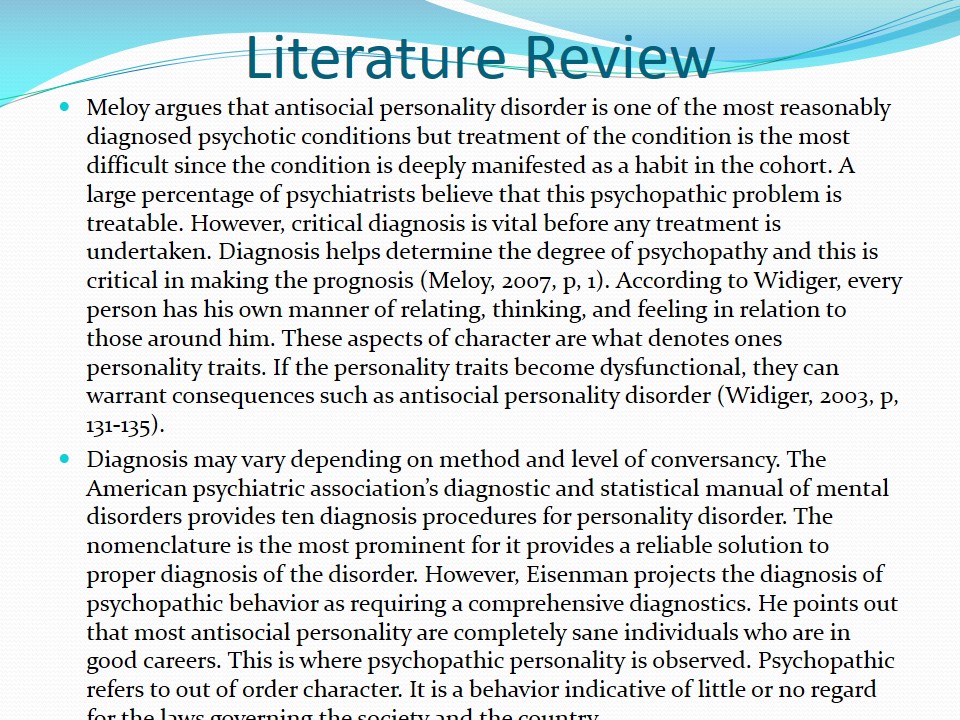
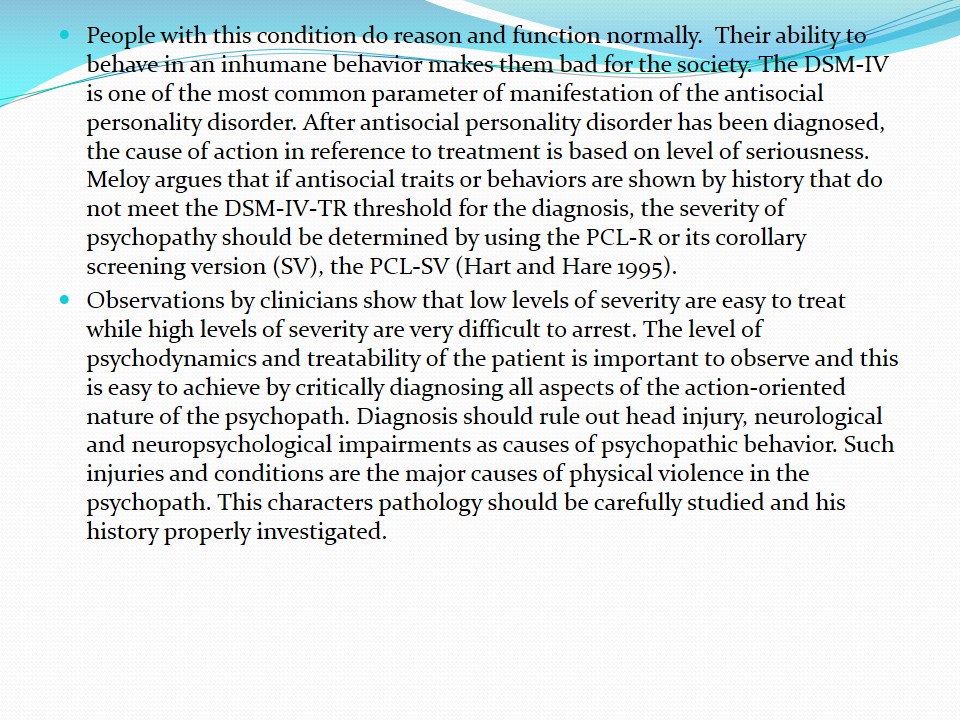
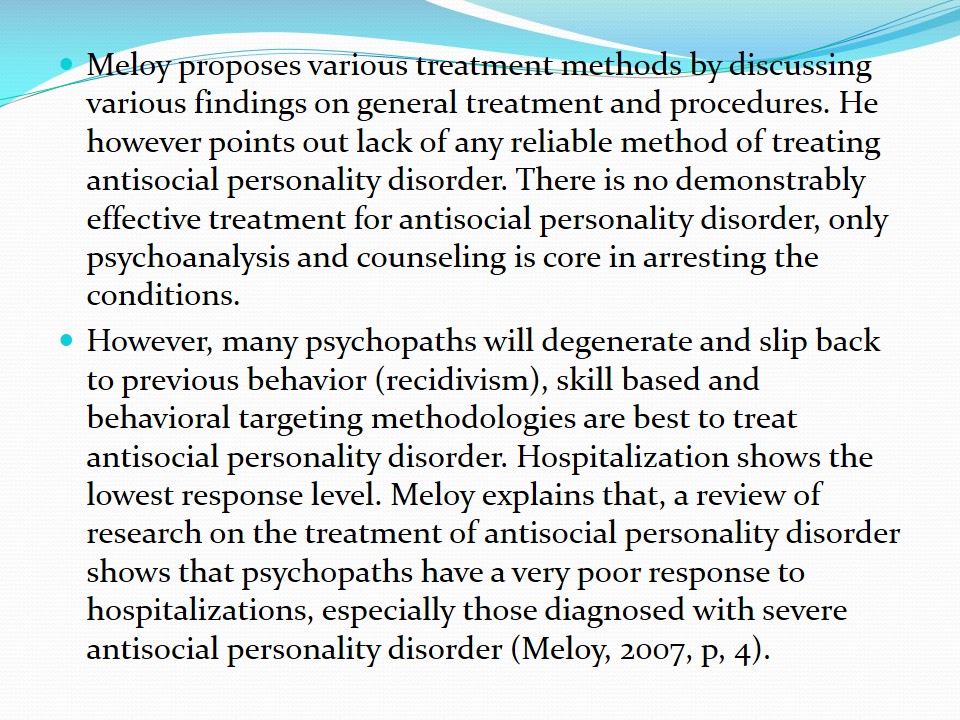
Discussion on treatment prognosis
Meloy singles out Hare and Schalings views about psychopathic thinking, that psychopathic criminals did not experience anxiety and worry. In comparison the criminals who are psychologically normal, the person suffering from a severe case of antisocial personality disorder, suffers no stress or anxiety. Anxiety is described as vital correlate of any successful mental health treatment. Clinicians argue that anxiety marks a capacity for internal psychological conditions as such, as the antisocial personality disorder manifests and the level increases; the anxiety level diminishes motivating the patient to be aggravative.
There are several treatment methods available and each is used depending on the level of psychopathy. Some methods like therapeutic nihilism are crude with the therapist doing what the cohort does to others. If he is mean and nagging, the therapist nags and becomes very mean to the patient. The objective is to stir a reaction to the men behavior and reverse the manifested behavior. As such, the patient’s character is forced to be a reagent to antisocial personality disorder. Incarcerations, normal counseling among other methods have been described as critical in treating psychopathy (Meloy, 2007, p, 4-10).
To treat Ann, counseling and using therapeutic nihilism is the best approach. Ann’s antisocial personality disorder shows a pattern of inability to respect people’s decisions. She likes bending rules to have her way. As such, if this is done to her in equal measure, while on the other hand, advice and propagation of habits is therapeutically introduced, Ann will react to seclusion by attempting to be friendly and obedient. She will try to evade doing negative things and will attempt to avoid doing things that irritate with a similar tenacity. Counseling will help her adapt to a new skillet, whereby, she does not subscribe to her antisocial personality, rather will focus on being positive.
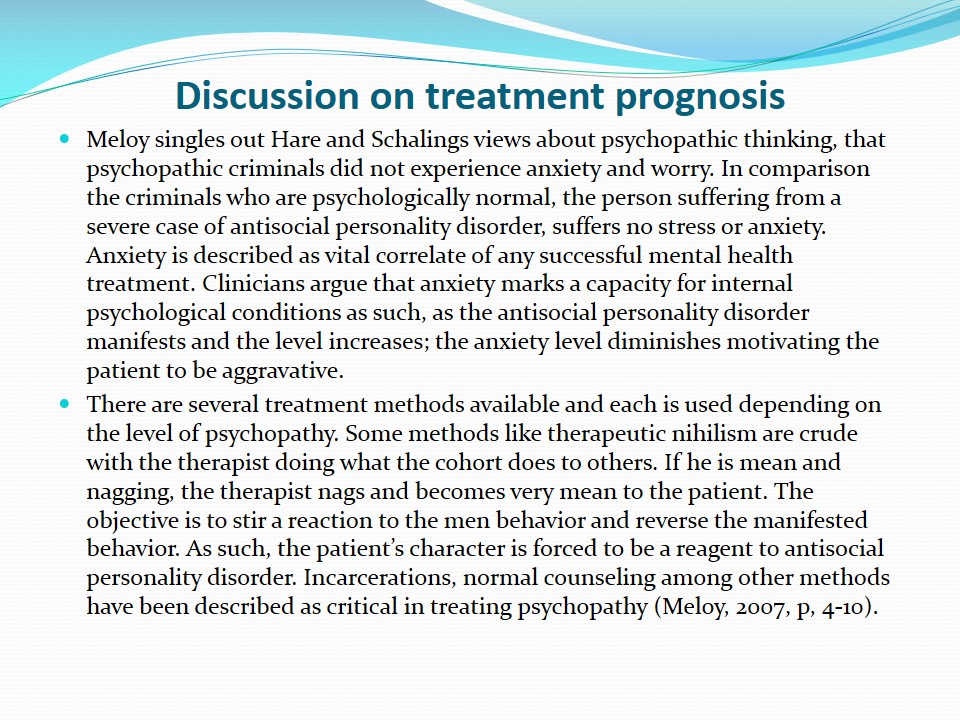
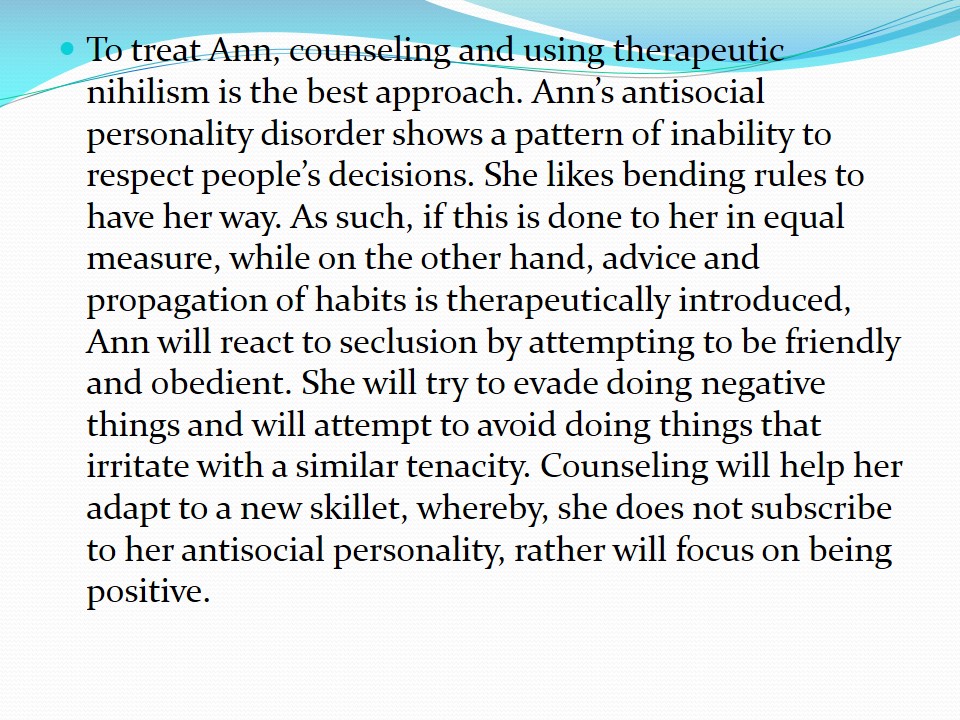
Summary
Clinicians assume a psychopath may reach psychological maturity. However, this maybe facilitated using therapy. Proper diagnosis of antisocial personality disorder is crucial in identifying level of severity. The level of severity determines the method of treatment. However, there is no cure or actual treatment of the antisocial personality disorder. Only therapeutic and counseling methods have been proposed and used to treat and arrest cases.
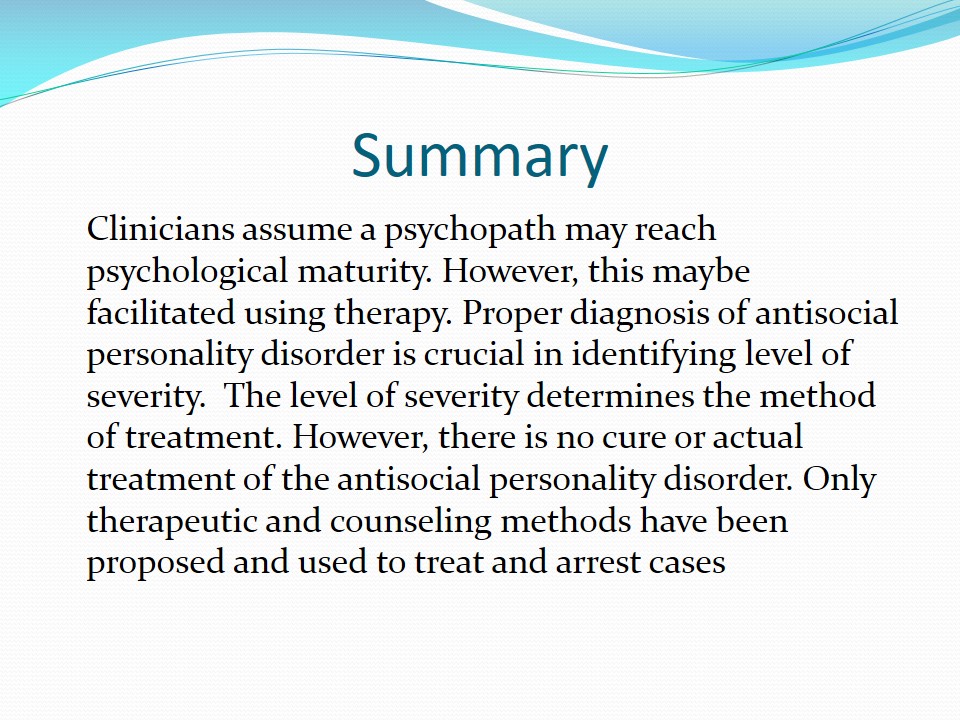
References
Eisenman, R. (1993). An Anti-social personality disorder: case history of a never-incarcerated youth. Journal of Police and Criminal Psychology, 9(1). Web.
Hart S, Hare RD: (1989) Discriminant validity of the Psychopathy Checklist in a forensic psychiatric population. Psychological Assessment 1:211–218.
Hart S, Hare RD: (1995). The Hare Psychopathy Checklist: Screening Version. Toronto, ON, Multi Health Systems.
Meloy, R. (2007). Antisocial personality disorder. Forensis, 1(1). Web.
Stutker, P, & Allain, A. (2002). Antisocial personality disorder. Comprehensive Handbook of Psychopathology. Web.
Widiger, T. (2003). Personality disorder diagnosis. World Psychiatry, 2(3). Web.